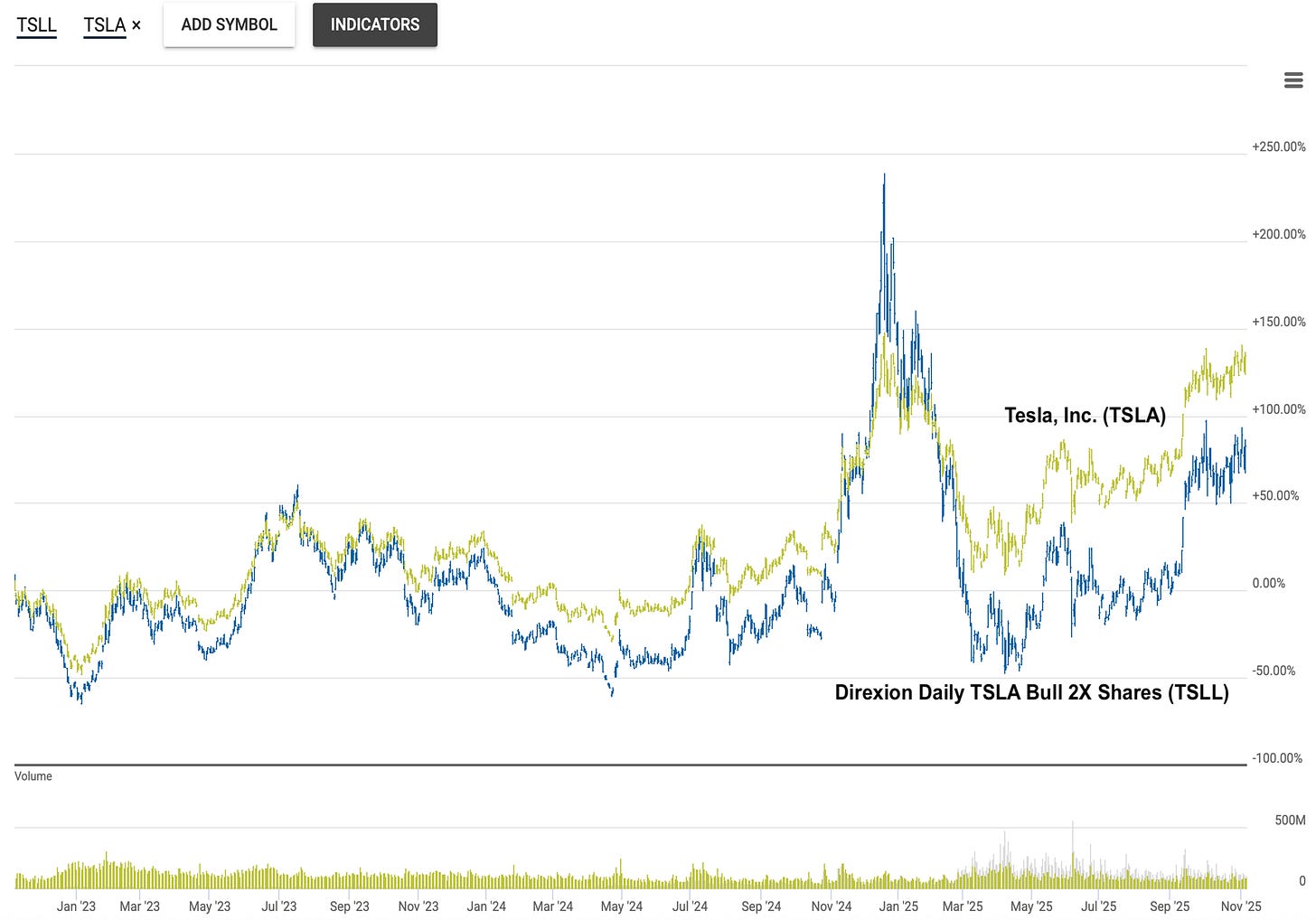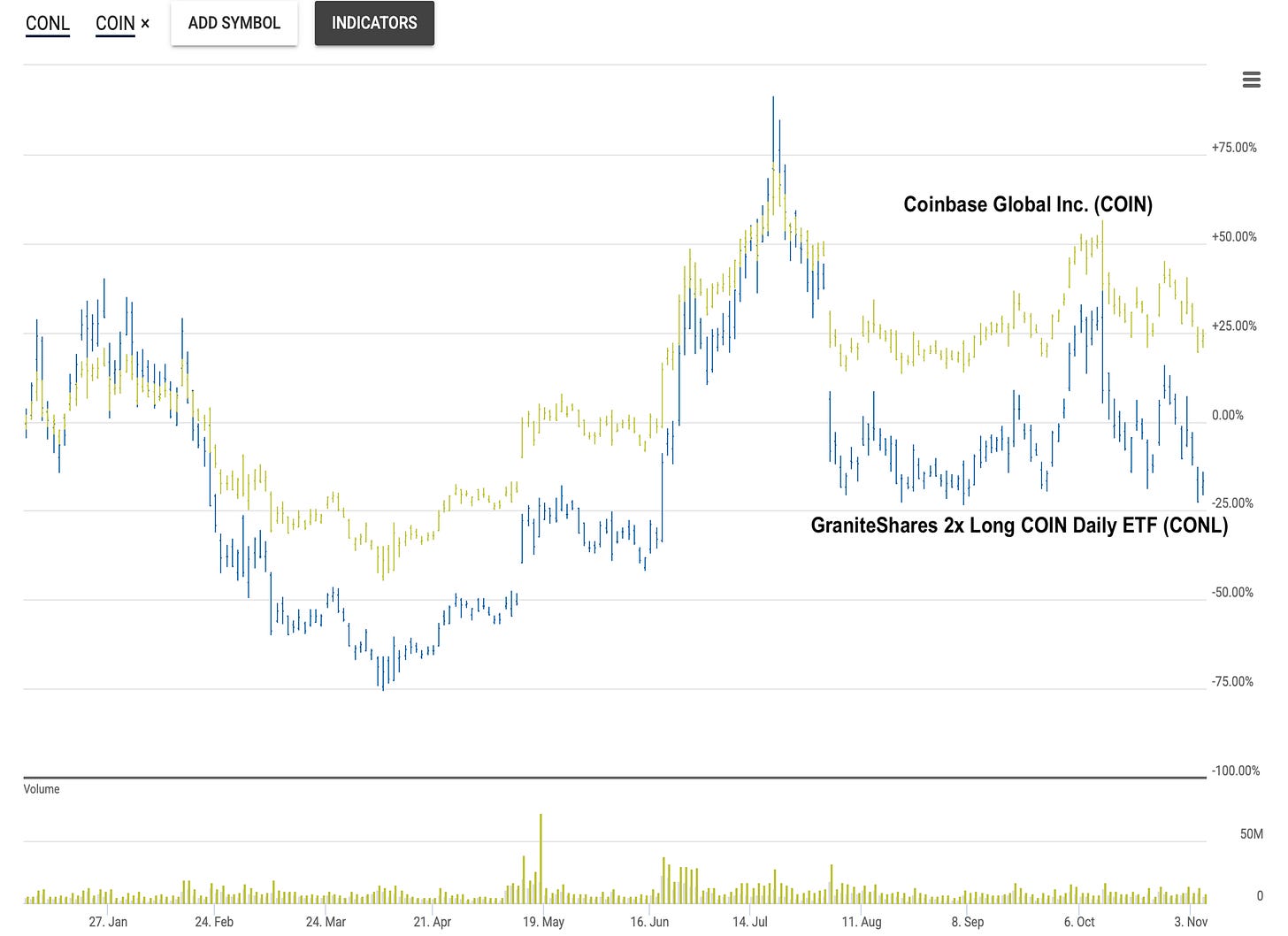Single-Stock ETFs Underperform the Stocks They Track
Leveraged single-stock ETFs promise amplified returns but often underperform the stocks they track. Learn why holding funds like TSLL or CONL long term can lead to major losses.
Leveraged single-stock exchange-traded funds (ETFs) have enriched their issuers, but not investors.
First launched in the U.S. approximately three years ago, single-stock ETFs are designed to track the performance of a single stock. They offer the possibility to realize double or even triple the return of a stock on a single day.
Among the oldest of these ETFs is the Direxion Daily TSLA Bull 2X Shares ETF (TSLL). It seeks to realize two times (200%) the return of Tesla Inc. (TSLA) shares on a daily basis, before fees and expenses. Holding it for longer than one day can lead to disappointing results.
Look at the chart below. Over the past three years, shares of Tesla have gained 135%. Shares of Direxion Daily TSLA Bull 2X Shares have realized a 64% return over the same period. Yes, you read that right—the ETF has realized just half Tesla’s return.
Three-Year Performance of TSLL and TSLA
Source: AAII.com, with data from QuoteMedia as of 11/5/2025.
Even over shorter periods, the returns can be far different from what an investor expects. The chart below depicts the year-to-date performance of the GraniteShares 2x Long COIN Daily ETF (CONL). It is designed to realize two times the daily percentage change of Coinbase Global Inc.’s (COIN) common stock, before fees and expenses.
Year to date through the close on Wednesday, November 5, 2025, GraniteShares 2x Long COIN Daily has fallen 11%. This drop in price has occurred even though shares of Coinbase Global are up 29% this year. Ouch!
Year-to-Date Peformance of CONL and COIN
Source: AAII.com, with data from QuoteMedia as of 11/5/2025.
The differences in returns directly stem from how leveraged single-stock funds are designed. They provide a multiple of the stock’s return (e.g., 2x) for a single day, not several days, months or years. Holding one of these funds for longer than one day results in compounded returns that will not match the performance of the stock being tracked.
Matthew Crouse, CFA, Ph.D., explained the concept in a 2020 AAII Journal article: “Consider an investment that increases 10% one day and decreases 10% the next. One dollar invested would be worth $1.10 after day one and $0.99 ($1.10 × 0.90) after day two. The arithmetic average return is 0%, and yet the investor has lost 1%.
“[Leveraged investment products] amplify this effect, which has been called volatility drag or volatility decay. Using our same 10% and –10% daily returns, a 3x-leveraged ETF would have a gain of 30% on day one and a loss of 30% on day two. One dollar invested would be worth $1.30 after day one and $0.91 ($1.30 × 0.70) after day two. The arithmetic average return is 0%, and yet the investor has lost 9%!”
These returns clearly make the case for owning the stock and not the single-stock ETF. Yet despite the disappointing performance for these and other leveraged single-stock ETFs, there is currently $40 billion of investor dollars placed in leveraged single-stock ETFs, according to VettaFi data cited by The Wall Street Journal.
We at AAII commonly tell individual investors to read the fact sheets and prospectuses before buying an ETF or mutual fund. We also strongly believe that no one should buy an investment they don’t fully understand. Leveraged single-stock ETFs fall into this category.
Even if you do understand the risks of a single-stock ETF and only intend to hold it for one day, realize that you are speculating and not investing. It is impossible to predict how a given stock or even the overall market will perform on a given day. The use of leverage only amplifies the price change and the magnitude of your potential loss.




